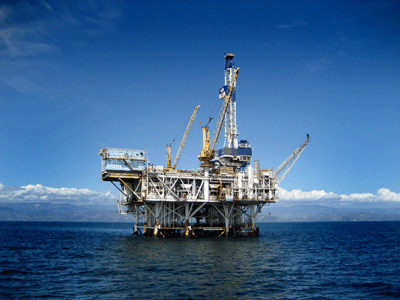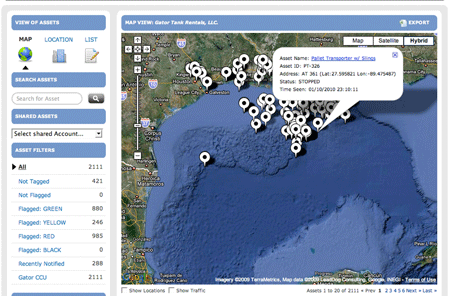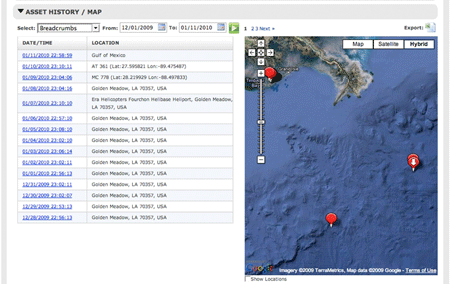In the high-stakes, capital-intensive oil and gas industry-where downtime due to lack of equipment or its failure can cost as much as $7 per second or $25,200 per hour-having the right oilfield equipment at the right location and right time is critical. Success is closely connected to timely and error-free delivery of product through a complicated, high-value supply chain. Proper equipment maintenance, inventory and asset management are not only regulatory issues, they are strategic operational imperatives for business performance.

Locating and managing valuable equipment in the oilfield has always been a challenge. It is a 24/7 operation with assets like: generators, pumps, heavy equipment, vessels and cargo baskets constantly in motion across frac pits, drilling rigs, platforms, shore bases, marine vessels and trucks.
Asset tracking and management has traditionally been a tedious, labor-intensive endeavor where operators and service providers have manually managed inventory counts in spreadsheets and sometimes been forced to guess the specific locations of assets. And that was just the equipment's location-maintenance or compliance information was a completely different set of data to maintain.
During the last decade, many have embraced new technologies like GPS and RFID to track the location of equipment and various inventories. While those technologies have afforded some nice operational benefits, they are still limited as standalone offerings.
Companies now have the ability to realize significant business intelligence and operational efficiency gains with new hybrid technology solutions like web-based asset tracking and management platforms. Many companies are now using such software and hardware solutions, which leverage a blend of GPS, RFID and other wireless technologies to automate and streamline the process of managing assets in the field. Companies simply log into a secure website to view the location of equipment in real-time and manage thousands of pieces of equipment with the click of a mouse.
Whether a company is managing 50 or 5,000 assets, the online asset management system helps it access the information it needs, including more than just equipment location. Ensuring equipment is properly serviced and certified to the latest industry standards is important. To simplify the process, the system offers the ability to automate compliance and equipment maintenance functions in tandem with tracking capabilities. For example, a flagging and alert system tracks routine maintenance and other tasks, automatically generating e-mail reminders when action is required. The system also enables users to store documents online such as: sling inspections, loading tests, certificates, engineering drawings and other requirements.
Many technology providers offer basic GPS tracking or RFID inventory management capabilities, but a web-based, hybrid approach combines the technologies to meet companies' unique, real-world needs by delivering the right blend of applications on a single platform. Unlike many options that lock users into a single solution, web-based, hybrid offerings are flexible, allowing companies to add new technologies and functionality to the platform when needed. For example, some companies need GPS for tracking today, but may consider RFID technology to manage inventory assets in fixed facilities in the future.

The map view of Gator Tanks' equipment in the Gulf of Mexico area.
One company that has capitalized on such a solution is EOG Resources, Inc., which leverages a web-based platform to manage more than $2 million of field equipment, including pumps, light towers and generators. One of the largest independent, non-integrated oil and natural gas companies in the United States with proven reserves in the United States, Canada, Trinidad, the United Kingdom and China, EOG Resources not only needed a technology solution to track equipment location, but also to manage engine runtime and maintenance tasks.
With expensive equipment scattered across multiple frac pits previously identified only by latitude and longitude, EOG Resources needed a more efficient way to find equipment within pits that in some cases were one mile in diameter. With a web-based hybrid system, it can assign addresses to its frac pits by plugging the right coordinates in the online system. The system also enables EOG Resources to identify the location of specific pieces of equipment within the frac pit, allowing them to more quickly and efficiently locate and service equipment.
Another company using a similar platform is Louisiana-based Gator Tank Rentals, a provider of offshore rental equipment and services for the oil and gas industry operating in the Gulf of Mexico. With a client roster including some of the world's largest oil and gas exploration and production companies, Gator Tank Rentals understands how important streamlined, efficient operations are in the trillion-dollar industry. Beyond providing mission-critical equipment and services that enable drilling operations, Gator Tank Rentals must continuously ensure equipment is effectively serviced and compliant with the latest industry requirements, including Department of Transportation and Coast Guard regulations.
After years of painstaking, manual inventory management of thousands of assets deployed in the field on behalf of many customers, Gator Tank Rentals CEO Carter Askew knew he needed a better way to manage the process. He envisioned a simple, affordable tracking system to help his company locate equipment, streamline operations and provide his customers the best service possible.
To meet this need, Askew selected a web-based asset tracking and management software platform that empowers his company with on-demand, 24/7 visibility into the location and status of valuable equipment deployed in the field. With the program, Gator Tank Rentals' staff can access a secure website anywhere, at any time to view the location of its assets on a map and gain visibility into its inventory in a facility or a remote location. For Gator Tank Rentals, the deployment has helped it achieve its goals of increased operational efficiencies, business intelligence and enhanced customer service. Today, Gator Tank Rentals manages the largest GPS oilfield equipment tracking and management deployment in the Gulf of Mexico.

The location history of a piece of equipment tracked in a web-based asset management system.
Intrinsically safe GPS tracking devices transmit position data to secure data centers one to four times per day using satellite communication networks, and web-based software manages the rest. Each asset's current and historical location is shown on Google Maps along with offshore lease block information. Virtual boundaries are set to generate e-mail alerts based on movement, and inventory at multiple locations can be managed automatically. Gator Tank Rentals also uses the software to manage lifting compliance related tasks for each asset such as mandatory visual inspections, load testing, magnetic particle inspection and more.
Shortly after the initial launch, Gator Tank Rentals began to share access to its equipment rental customers, which include some of the largest operators in the world. Its customers now have anytime visibility into the location of their assets in the field with their own secure online accounts. Because its exploration and production customers have a shared interest in knowing where their equipment is located and in ensuring equipment is compliant and operational at all times, the customers have come to rely on this value-added service as a true operational advantage. Gator Tank Rentals can differentiate itself from the competition.
Gator Tank Rentals and EOG Resources' use of the new hybrid approach to asset management and tracking technology illustrates how operators and service providers can maximize the benefits of GPS, RFID and other wireless technologies to optimize operational efficiency. In an industry where downtime and inefficient field operations can be crippling, the introduction of a new breed of innovative, easy-to-use technology solutions are helping companies in the oil and gas industry be more efficient, informed and profitable.

